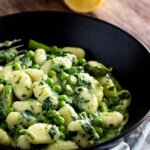
Gnocchi Primavera with Creamy Parmesan Sauce
Soft pillows of potato, coated in a rich and creamy parmesan sauce, with spring vegetables and a hint of lemon.
Servings 4
Calories 365kcal
Ingredients
Gnocchi
- 2 tsp extra virgin olive oil
- 3 cloves garlic, finely diced
- 1 cup asparagus, cut into 2cm pieces (Note 1)
- 1 cup peas, frozen
- 1 cup chopped spinach, frozen (Note 2)
- 2 tbsp fresh chives, finely diced
- 500 g packet of gnocchi (Note 3)
Creamy Parmesan Sauce
- 1/2 cup milk, low fat (Note 4)
- 3/4 cup parmesan cheese, finely grated (Note 5)
- 1/3 tsp lemon rind, finely grated
Instructions
- Fill a large pot with water, place over high heat and bring to the boil.
- Heat the extra virgin olive oil in a large skillet over medium-high heat. Add the garlic to the skillet and cook for 1 minute or until lightly golden and fragrant.
- Add the asparagus to the skillet and cook for 2 minutes. Then, add the frozen spinach and peas into the skillet. Cook for 1 minute or until the spinach has softened.
- Pour the milk into the skillet, bring it to a gentle simmer, and then remove it from the heat.
- Pour the gnocchi into the boiling pot of water. Once most of the gnocchi has risen to the top of the water, cook for a further 2-3 minutes. Transfer the cooked gnocchi to the skillet using a slotted spoon and stir to mix. Add the lemon rind to the skillet and give a quick stir through.
- Sprinkle the parmesan cheese over the gnocchi and stir for 2-3 minutes or until it melts to create a creamy sauce.
Notes
- Asparagus - You can substitute fresh asparagus for canned, just rinse (to remove excess sodium) and add it in step 4.
- Spinach - You can use fresh silverbeet/swiss chard instead of frozen spinach. I recommend removing any hard stems, roughly chop the silverbeet/swiss chard and add it to the skillet before the asparagus. Once the leaves start to wilt, add the asparagus and continue as per the recipe. Or, for baby spinach, add it in with asparagus in step 3 and cook until wilted. If using fresh peas, throw them in at step 5.
- Gnocchi - Store bought gnocchi can be very high in sodium. Choose the brand that has the lowest sodium per 100g, I used the Coles Kitchen potato gnocchi.
- Milk - If you want to use plant-based milk, choose one that is unsweetened and calcium-fortified.
- Parmesan - I used the Coles brand Parmigiano Reggiano. You can use other Italian cheeses, such as Pecorino or Grana Padano, or just about any cheese that melts. Grana Padano is cheaper and has a milder flavour than Parmesan, but you can easily boost the flavour by adding a small amount of nutritional yeast. Beware of buying supermarket home brand shredded cheeses, as they contain an anticaking agent, which prevents the cheese from melting smoothly.
- Storage - Should last up to 3 days in an airtight container in the fridge.
- Nutrition - Calculated per serve, assuming 4 serves.
Nutrition
Serving: 273g | Calories: 365kcal | Carbohydrates: 56g | Protein: 16g | Fat: 7.6g | Saturated Fat: 4g | Polyunsaturated Fat: 0.5g | Monounsaturated Fat: 3g | Cholesterol: 15mg | Sodium: 380mg | Potassium: 385mg | Fiber: 7.1g | Sugar: 4.5g | Vitamin A: 5609IU | Vitamin C: 20mg | Calcium: 374mg | Iron: 7mg